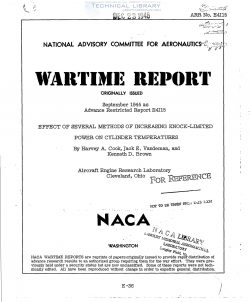naca-wr-e-36
- Version
- 70 Downloads
- 1,013.98 KB File Size
- 1 File Count
- April 15, 2017 Create Date
- April 15, 2017 Last Updated
Effect of Several Methods of Increasing Knock-Limited Power on Cylinder Temperatures

In evaluation of each of these six conditions on the basis of
engine knock, consideration must be given to their effect on cyl-
inder temperatures at knock—limited power. Two sets of cylinder
temperatures are of interest - external and internal. Tie external
temperatures are used in flight to determine whether the engine is
adequately cooled. The limiting values of these temperatures are
based on the manufacturer's specifications for safe operation of
the engine. Certain internal cylinder temperatures, namely, the
exhaust valve (reference 1) and the spark-plug electrodes bear no
direct relationship to the external cylinder temperatures. These
temperatures are important because of their relationship to engine
durability and because they are potential sources of preignition
if the temperatures are not adequately controlled. Data on the
relation of cylinder~head temperatures to knock-limited power have
been presented to the Coordinating Research Council by Pratt &
Whitney.Aircraft Corporation. The effects of internal coolants on
knock-limited and temperature-limited power are given in reference 2.
In the present report, tests are described in which the knock-
limited power was determined as a function of each of the previously
listed six engine conditions. For each test the following tempera-
tures are presented: rear spark—plug bushing, middle rear barrle,
exhaust—valve crown, front sparkvplug electrode, rear sparkhplug
electrode, and exhaust gas.
This inyestigation was conducted in.chember 1943 at the
Aircraft Engine Research.Laboratory of the NACA at Cleveland, Ohio.
The data for this report were obtained on a wright R—ZBOO~8
front—row cylinder fitted with standard baffles and mounted on a
CUE crankcase (figs. 1 and 2). A Stancal pickup unit and an oscil-
lograph were used for indication of knock.
The cylinder temperatures were measured by thermocouples
located as shown in figure 5. Only the temperatures listed in the
preceding section are presented because they are considered to
represent the critical locations.
| File | Action |
|---|---|
| naca-wr-e-36 Effect of Several Methods of Increasing Knock-Limited Power on Cylinder Temperatures.pdf | Download |

Comment On This Post